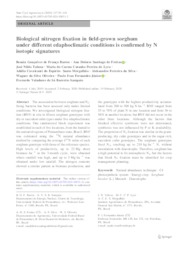Biological nitrogen fixation in field-grown sorghum under different edaphoclimatic conditions is confirmed by N isotopic signatures.
Biological nitrogen fixation in field-grown sorghum under different edaphoclimatic conditions is confirmed by N isotopic signatures.
Author(s): BARROS, B. G. de F.; FREITAS, A. D. S. de; TABOSA, J. N.; LYRA, M. do C. C. P. de; MERGULHÃO, A. C. do E. S.; SILVA, A. F. da; OLIVEIRA, W. da S.; FERNANDES JUNIOR, P. I.; SAMPAIO, E. V. de S. B.
Summary: The association between sorghum and N2-fixing bacteria has been assessed only under limited conditions. We investigated biological nitrogen fixation (BNF) in situ in fifteen sorghum genotypes with dry or succulent culm types under five edaphoclimatic conditions. One randomized block experiment was established in each of five locations, from the humid to the semiarid regions of Pernambuco state, Brazil. BNF was estimated using the 15N natural abundance method by comparing the average d15N value of each sorghum genotype with those of the reference species. High levels of productivity, up to 22 Mg shoot biomass ha-1 in the 3-month cycle, were obtained where rainfall was high, and up to 5 Mg ha-1 was obtained under low rainfall. The nitrogen contents showed a similar pattern as biomass production, and the genotypes with the highest productivity accumulated from 200 to 300 kg N ha-1. BNF ranged from 55 to 78% of plant N in one location and from 36 to 56% in another location, but BNF did not occur in the other three locations. Although the factors that blocked effective symbiosis were not determined, symbiosis was not influenced by P or K availability. The proportion of N2 fixation was similar in the grainproducing, dry culm genotypes and in the sugar-rich, succulent culm genotypes. The sorghum genotypes fixed N2, reaching up to 218 kg ha-1 N, without inoculation with diazotrophs. Therefore, sorghum has a high potential to fix atmospheric N2, but the factors that block N2 fixation must be identified for crop management planning.
Publication year: 2020
Types of publication: Journal article
Unit: Embrapa Semi-arid Region
Observation
Some of Embrapa's publications are published as ePub files. To read them, use or download one of the following free software options to your computer or mobile device. Android: Google Play Books; IOS: iBooks; Windows and Linux: Calibre.
Access other publications
Access the Agricultural Research Database (BDPA) to consult Embrapa's full library collection and records.
Visit Embrapa Bookstore to purchase books and other publications sold by Embrapa.

